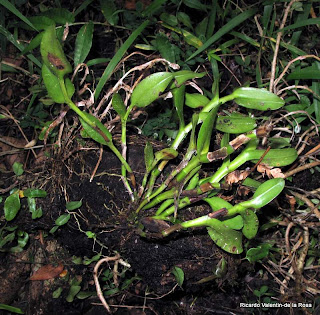 |
| Some of the flowers have a slight whitish tint that appears more pronounced under flash photography |
 |
| A recently fallen branch with a clump of orchids, note that there are the dried stems of several dead clumps around the living plant. |
 |
| There is a developing seed pod in the right lower corner of the photo |
 |
| A large healthy clump flowering profusely, this one is growing in the sierra palm forest |
 |
| This plant is growing in the lower part of the elfin forest |
This orchid native in PR was described in the year 1993. Before that year it was commonly known as Epidendrum difforme. But research on the identity of the original species revealed that there were dozens of green flowered Epidendrum species that were classified as difforme because the flowers and the plant body were similar. One of the species that was revealed as a distinct entity was Epi. boricuarum, the name alludes to the name that is applied to the people of Puerto Rico. This orchid has been found in the islands of Hispaniola, Puerto Rico and Guadaloupe.
In Puerto Rico this species is widespread and at times quite common in areas of favorable habitat. I have found it growing in various settings from the trunks of palms, branches and rotten tree stumps. It seems to favor the edge of the forest where light penetrates considerably deeper into the forest than in areas of continuous canopy. But perhaps this is just a byproduct of the places where I find easier to move through the forest.
The canes of the plants are about ten to twelve inches tall and often form clusters of growths. The plants tend to open all its flowers at the same time. The flowers are green, they are said to become fragrant at night and to produce a fragrance reminiscent of cucumbers. In the wild it is common to find plants that have fallen to the ground when the branch they were growing on died and decayed. If the branch falls in a reasonably sunny, well drained area the orchids will survive (at least until the branch decays completely), if they fall in a shady wet spot they die.
From time to time you see plants of this species in captivity but healthy well grown plants are a rarity. I asked a few orchidist about the culture of this species and they remarked that it usually dies in captivity. I have seen impressive specimen plants of this species on shows but I suspect the reason is that some people grow this plant in areas where it is native and therefore in its optimum environmental conditions.
Although this plant has obvious horticultural merit it is rarely seen mainly because local orchid grower tastes tend to run toward hybrids which are inexpensive, easy to find and spectacularly colored. Green flowered orchids are not popular locally. I recall that a local orchid hybridizer from Utuado, Mr. Eli Santiago did some hybridizing with this species, but I have not seen the hybrids in orchid shows.
Since there seems to have been some importations into Puerto Rico of other species under the “Epi difforme” label there may be some confusion as to the appearance of the flowers of boricuarum when seen in orchid shows. Since these flowers were photographed from plants in situ, there is little doubt as to their identity.













No comments:
Post a Comment